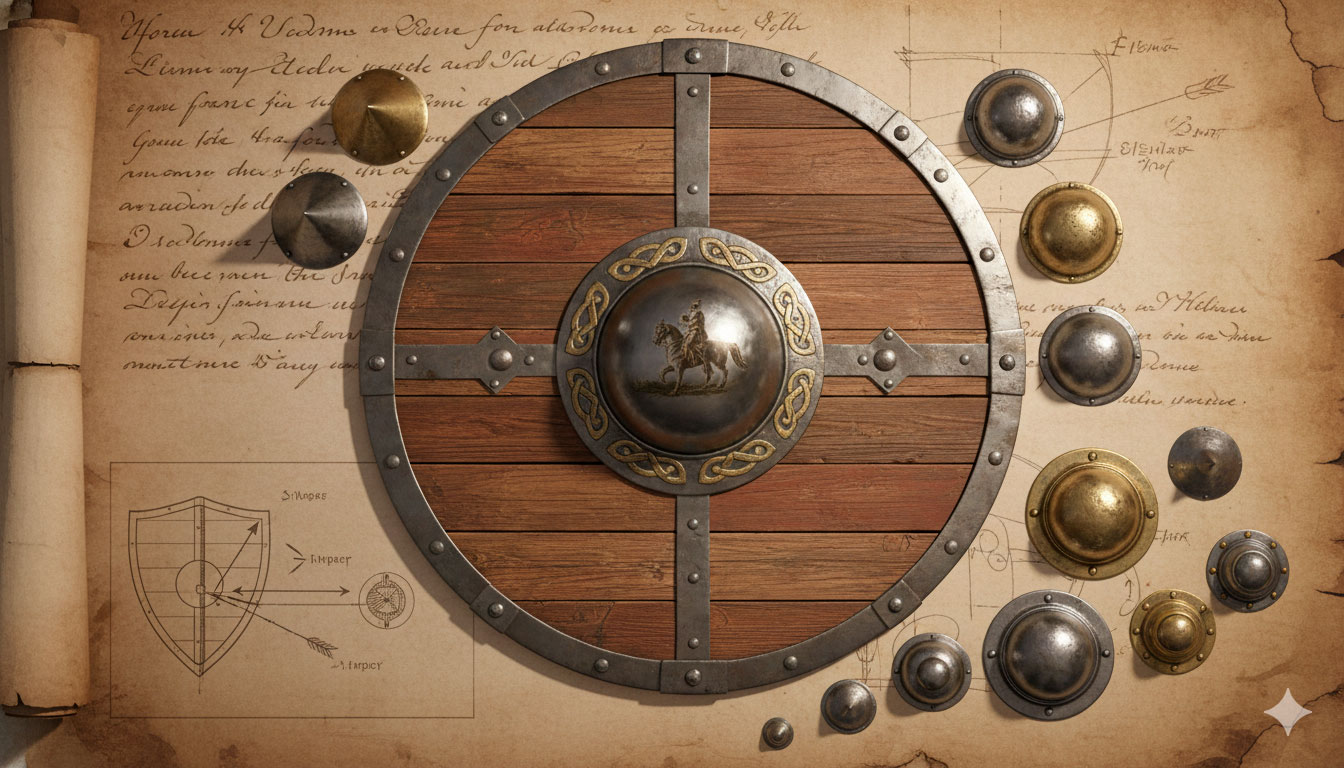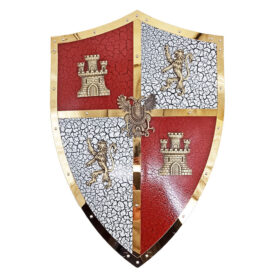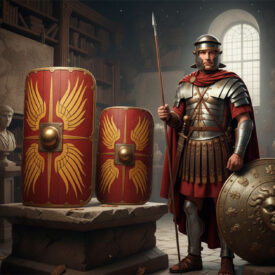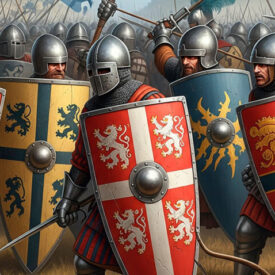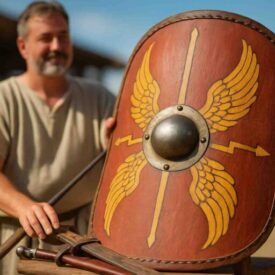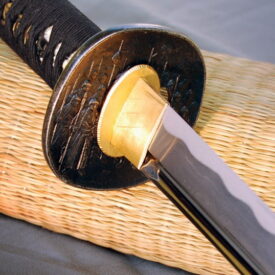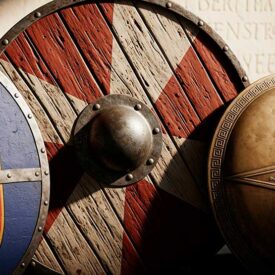What secrets did medieval warriors keep in the heart of their shields? Beyond wood and leather, a piece of forged metal stood, not just as a protector, but as a deadly extension of their will. We are talking about the umbo, that mysterious component that defined the line between ironclad defense and swift attack. Through this journey, we will unveil the authentic history and vital function of umbos in medieval shields, exploring why their presence was so indispensable for survival and dominance on the battlefield.
The Heart of Defense: The True Function of the Medieval Umbo
The umbo, or umbona, was much more than a simple metallic protrusion; it was the epicenter of a warrior’s defensive and offensive strategy. Its design, often hemispherical or conical, arose from the critical need to protect the most vulnerable point of any shield with a central grip: the wielder’s hand.
Protecting Glory: The Warrior’s Hand
Imagine an ancient conflict, where the clang of metals and the clamor of battle resonated ceaselessly. Amidst this chaos, the hand holding the shield was a priority target for the enemy. The umbo rose as an unyielding sentinel, an unbreakable barrier that intercepted blows and thrusts, safeguarding the vital extremity that ensured the continuation of combat. Without this protection, a single unfortunate blow could mean defeat and death for the warrior.
The Shield’s Backbone: Reinforcement and Resistance
But the umbo not only protected the hand; it also served as the structural anchor that maintained the shield’s integrity. Acting as a force distributor, it deflected the energy of the fiercest impacts, preventing the shield’s wood from splitting or splintering. This central reinforcement was crucial, transforming a simple wooden board into a bulwark capable of withstanding the onslaught of swords, axes, and spears.
The Art of Deflecting Death: Deflection Engineering
The convex shape of the umbo was no accident; it was a stroke of ballistic engineering genius. Its curvature was designed to deflect attacks, redirecting the force of impact tangentially and drastically reducing the energy transmitted to the grip point. It was an active armor, capable of deceiving enemy weapons and causing them to slide harmlessly, protecting the warrior from the most devastating blows.
Beyond Defense: The Umbo as an Offensive Weapon
Although its primary function was defensive, the umbo was not a passive companion in battle. In the hands of an experienced warrior, it became an extension of their will, a blunt weapon capable of inflicting damage and opening gaps in the enemy’s defense.
The Surprise Blow: Breaking Defenses
In the heat of hand-to-hand combat, the umbo allowed the warrior to strike and push, unbalancing the opponent and creating openings for sword or axe attacks. Roman legions, for example, were experts in this tactic, using their umbos to break through enemy lines before unleashing the power of their gladius. Conical umbos, with their pronounced point, were especially lethal, concentrating the impact for a more penetrating blow.
Control in Chaos: Biomechanics and Efficiency
 The design of the umbo was also intended to minimize warrior fatigue and maximize control. The concentration of mass in the center of the shield functioned as a dynamic counterbalance, allowing for faster rotation and greater maneuverability. A light and well-balanced umbo reduced effort, allowing the warrior to maintain agility and precision during hours of battle, a crucial factor for survival in medieval warfare.
The design of the umbo was also intended to minimize warrior fatigue and maximize control. The concentration of mass in the center of the shield functioned as a dynamic counterbalance, allowing for faster rotation and greater maneuverability. A light and well-balanced umbo reduced effort, allowing the warrior to maintain agility and precision during hours of battle, a crucial factor for survival in medieval warfare.
History in Iron: The Chronology of the Umbo
The umbo in shields: function and historical evolution
The umbo — the central metal piece of many shields — was born as hand protection and structural reinforcement. Throughout Antiquity and the Middle Ages, its role evolved according to tactics and shield types: from an offensive object in Rome to an essential element in central-grip Viking shields, only to decline with the arrival of the elongated cavalry shield.
| Era | Event |
|---|---|
| Origins and Early High Middle Ages (Antiquity – 8th century) | |
| Ancient Greece | Initial documented use: umbos on hoplite shields to protect the wielder’s hand and reinforce the center of the shield. |
| Ancient Rome | Adoption and offensive use: Roman legions used the umbo not only for protection but also for striking in hand-to-hand combat, facilitating the use of the gladius. |
| 3rd–2nd centuries BC | Archaeological evidence of umbos in Vettonian and Iberian shields, confirming their widespread use in the Iberian Peninsula. |
| c. 625 AD | Anglo-Saxon context (Sutton Hoo): ship burials and associated material indicate local production within cosmopolitan networks, including shield components with umbo. |
| 7th century AD | Continental finds: Lombard umbos in northern Italy; some typologies (R562 and R564) derive from Merovingian models. |
| Apex: Viking Age and Classical High Middle Ages (9th–11th centuries) | |
| 793–1066 AD | Viking Age: the round shield with central grip and metal umbo was the most common defensive weapon; the umbo protected the hand and reinforced the center of the shield. |
| 9th–11th centuries | Archaeological studies: more than 55 continental and Scandinavian umbos (sites such as Haithabu, Birka, and Gnězdovo) have been cataloged and analyzed to determine dimensions and typologies. |
| 9th–11th centuries (technical function) | Deflection engineering: the convex shape (hemispherical or conical) redirected the force of impact; the dome was thicker (approx. 0.6 cm to 0.7 cm) to maximize resistance. |
| 9th–11th centuries (tactics) | Shield wall (Schildwall): the solidity of the central umbo was vital for formations to resist pushes and maintain cohesion in combat. |
| Transition and decline (late 10th – 12th century and later) | |
| Late 10th – early 11th centuries | Rise of cavalry: the round central-grip shield began to be abandoned because it was uncomfortable for the rider who had to hold the reins. |
| c. 1000 AD | “Ovoid” designs: representations (e.g., the Aachen situla) show oval shields that could be a transitional form or an alternative contemporary design. |
| 11th century | Introduction of the kite shield: being tied to the arm with straps (enarmas) and better protecting riders, it made the central hole and, in many cases, the protective umbo obsolete. |
| 1140–1150 | Late iconographic evidence: Norman figures with umbos on their shields appear, for example, in the Temple Pyx, showing a stylized or regional survival of the element. |
| Late medieval and post-classical | Functional survival in small formats: although it disappeared from cavalry shields, the umbo continued in smaller central-grip shields, such as the buckler, used in foot combat. |
Resolve your doubts about the evolution and function of umbos in the Middle Ages
How did umbos evolve throughout the Middle Ages?
Throughout the Middle Ages, umbos evolved from simple, functional metal protrusions to more elaborate and decorative elements. Initially, their main function was to protect the wielder’s hand and reinforce the shield’s structure, deflecting blows and projectiles. Over time, umbos became larger and more prominent, especially on round and cavalry shields, and began to be used offensively to ram or destabilize the enemy. In the Late Middle Ages, some umbos acquired more ornate and artistic forms, reflecting the warrior’s status or identity, although their practical use decreased with the emergence of new grip systems and the evolution of armor.
What materials were commonly used to make umbos?
 Umbos were commonly made from steel, brass, and wrought iron. In some cases, wood and bone were also used.
Umbos were commonly made from steel, brass, and wrought iron. In some cases, wood and bone were also used.
Steel was the most popular material due to its greater robustness and impact resistance. Steel umbos were forged by heating and hammering the metal, allowing them to achieve a high level of durability.
Brass was mainly used for aesthetic reasons, as it offered a more elegant and visually attractive finish, although it was less resistant than steel.
Wrought iron was especially common in Viking umbos, using heating and hammering techniques for their manufacture.
The choice of material depended on several factors, including the era, culture, and purpose of the shield. While more resistant materials like steel provided better protection in combat, others like brass were selected when personal representation and aesthetics were prioritized.
What was the primary function of an umbo in a medieval shield?
The primary function of an umbo in a medieval shield was to protect the wielder’s hand and reinforce the shield’s center to deflect blows from enemy weapons. Additionally, it served as an attachment point for the grip and, in some cases, could be used as an offensive weapon in hand-to-hand combat.
How did umbos influence the combat tactics of medieval warriors?
Umbos significantly influenced medieval combat tactics by offering both defensive and offensive advantages that warriors strategically exploited.
Deflection and deviation of blows
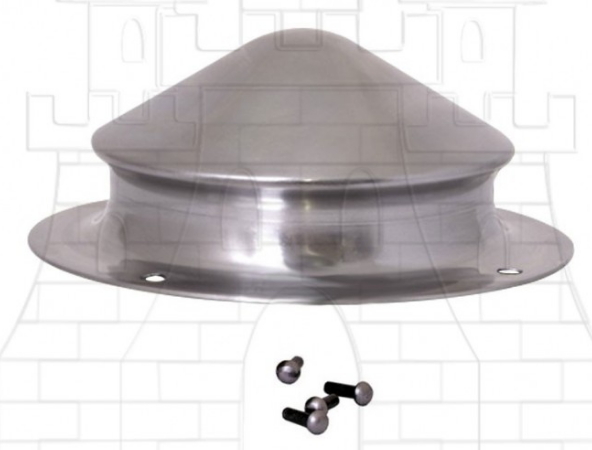 The umbo’s design allowed for more efficient deflection of enemy attacks. Conical umbos, particularly popular among medieval warriors, were specially designed to redirect the force of blows at more favorable angles, reducing direct impact on the shield and its wielder. This deflection capability was fundamental in prolonged engagements where fatigue played a decisive role.
The umbo’s design allowed for more efficient deflection of enemy attacks. Conical umbos, particularly popular among medieval warriors, were specially designed to redirect the force of blows at more favorable angles, reducing direct impact on the shield and its wielder. This deflection capability was fundamental in prolonged engagements where fatigue played a decisive role.
Variation according to the type of combat
The choice of umbo directly depended on the tactic intended to be used. Hemispherical umbos combined good blow deflection with a low profile, making them ideal for closed formations where warriors maintained compact and coordinated positions. For their part, round umbos provided broader coverage and additional protection, allowing for greater defensive versatility. Square umbos, although less common, offered greater structural resistance and were used when more robust protection was needed.
Hand protection and shield control
Beyond its defensive function, the umbo acts as an attachment point for the wielder’s arm. This feature was crucial for maintaining control of the shield during hours of combat, allowing warriors to maneuver with greater agility and precision. A well-designed umbo protected the hand from cuts and direct blows, keeping the warrior in optimal combat conditions for longer periods.
What were the differences between the umbos of Roman and medieval shields?
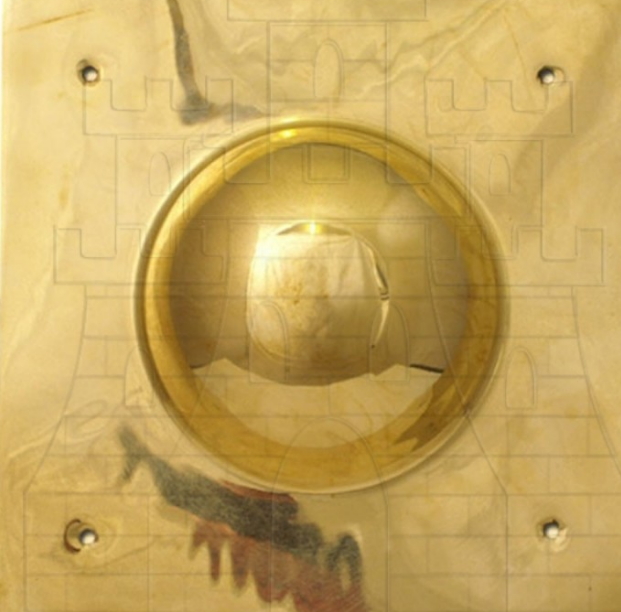 The differences between the umbos of Roman and medieval shields lie mainly in their shape, function, and design:
The differences between the umbos of Roman and medieval shields lie mainly in their shape, function, and design:
- Roman Umbos: Generally, they were semi-spherical or elliptical, convex metal pieces, fixed in the center of the shield (as in the scutum), which protected the hand, reinforced the structure, and could be used offensively to strike the enemy in hand-to-hand combat. Their design was highly oriented towards military functionality, being simple but robust, made of metals like iron or copper and brass alloys.
- Medieval Umbos: Popularized from the 12th century onwards, they were also central protrusions to protect the hand, but with greater variety in shape (round, square) and materials (metal, wood, bone). Over time, they became more elaborate and decorative, in addition to being functional, especially on heavier knightly shields. Square umbos, for example, were less common but provided greater protection.
While Roman umbos were primarily functional tools with a clear offensive character, medieval umbos acquired greater formal and decorative diversity, although they maintained the basic function of protection and reinforcement of the shield.
From the battlefields of ancient Greece to Viking skirmishes and medieval tournaments, the umbo has proven to be a fundamental piece in the evolution of the art of war. Its presence not only guaranteed the warrior’s survival but also influenced combat tactics and the very conception of the shield as a multifunctional weapon. By understanding the true purpose of this metallic protrusion, we can better appreciate the complexity and ingenuity of military engineering of yesteryear. Thus, the umbo stands as a silent testament to the struggle for survival and dominance in a world where steel and skill decided fate.
